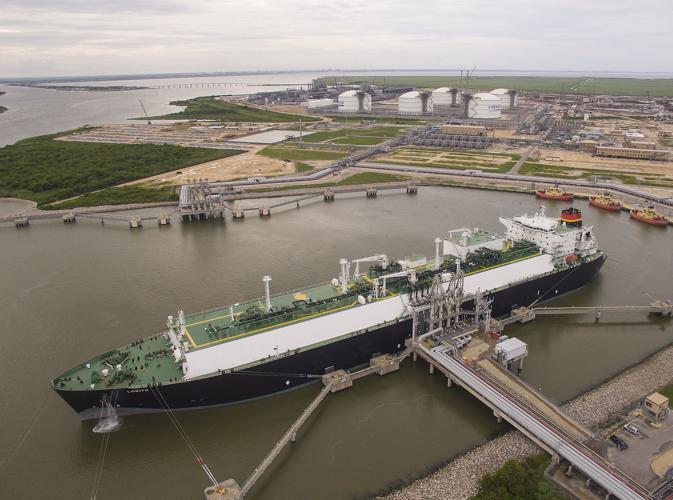More than $90 billion of liquefied natural gas projects are in various stages of construction or planning in Louisiana, representing a wave of around a dozen companies trying to cash in on peak global demand in the early 2020s.
Exactly how many of those projects come to pass will depend on who can land contracts and secure financing in the coming years, and whether an escalating trade war with China--perhaps the most important global market--derails the industry’s momentum.
“China is the big elephant in the room,” said Bill Rase, executive director of the Port of Lake Charles. “If China’s not happy...you might only have a couple more of these things be built.”
Regardless, experts say not all of the 10 or so projects that have been announced so far will materialize.
But Louisiana, particularly the southwest region of the state around Lake Charles, has become a key part of the global LNG trade in recent years, as it has begun exporting cheaper natural gas to places like China, India and Poland. Those countries, meanwhile, are looking for ways to shift away from coal and toward cleaner-burning natural gas.
That, coupled with Louisiana’s geography--and its billions in tax breaks to businesses--has attracted a crop of LNG mega-projects, including two currently under construction: Cheniere Energy’s Sabine Pass LNG Terminal, a nearly $20 billion facility on the Louisiana-Texas border, and Cameron LNG’s $10 billion in Hackberry.
Cheniere’s facility in 2016 became the first in the U.S. to export LNG. Cameron LNG is under construction and could send shipments by 2019.
In all, projects that are under construction or have been approved totals $40.5 billion, according to Louisiana Economic Development. Another $52 billion in projects have been announced but not yet approved. More than 10,000 direct and indirect jobs are promised from the planned projects.
At least two of those have approval and are awaiting construction: Lake Charles LNG, a $9 billion project by Shell and Energy Transfer; and Magnolia LNG, a $3.5 billion facility from Australia-based Liquefied Natural Gas Limited.
A host of others are possible. Tellurian Inc. has plans for a $30 billion project called Driftwood LNG, on the Calcasieu River, which would include a $15.2 billion spend on direct engineering, procurement and construction costs, representing one of the largest investments in Louisiana history. Venture Global LNG has plans for facilities in Calcasieu and Plaquemines parishes. Former Gov. Buddy Roemer even got in on the action as part owner of G2 LNG, with plans for a $11 billion facility in Cameron Parish. One project, from Delfin LNG, is even planned to float offshore.
Rase said he expects all of the projects planned for Calcasieu Parish to receive approval from the Federal Energy Regulatory Commission by the end of next year, as companies try to get facilities up and running by the time global demand is forecast to peak, in 2022 or 2023.
So far, China has not put a retaliatory tariff on U.S. LNG, sparing the industry disaster for now. But Tulane University economics professor Eric Smith warned that is likely because they are more or less forced to buy from the U.S. at the moment. Once global supply catches up, that could change.
The other headwind for the industry is the steel and aluminum tariffs President Donald Trump slapped on imports. Those could spell higher costs for LNG projects that need specialty metals sourced from other countries, Smith said.
A recent uptick in crude oil prices has given the LNG industry some “breathing room,” said David Dismukes, professor at LSU’s Center for Energy Studies. That’s because in Asian markets, natural gas prices are tied to crude oil prices, which means U.S. gas priced at the Henry Hub--which stays flat--becomes cheaper and more attractive.
The biggest handicap is whether they can land contracts, something LNG developers have struggled with.
“The ones that can sign deals and get to market quickest are the ones that are going to get developed,” Dismukes said.
Dismukes said a rosy estimate of the industry is six or seven more LNG projects getting developed in Louisiana. Even that is pushing it, as global demand won’t rise forever.
But even if a share of those LNG projects fall through, the southwest Louisiana region has already experienced a boom in industrial construction, and continued good news on the job front.
In all, the region has nearly 20,000 construction workers laboring on a crop of mega-projects, said George Swift, president and CEO of the Southwest Louisiana Economic Development Alliance.
The thousands of workers have flooded the region, taking up RVs and apartments as they work to complete both LNG and other petrochemical projects, like Sasol’s $11 billion ethane cracker, Swift said. Of course, the area is also seeing more traffic.
Swift said he’s looking forward to when the area moves beyond merely the construction phase, and can put several thousand people to work in permanent jobs staffing the plants. While the industries building there are capital intensive, and don’t require a great deal of permanent employees to operate the facilities, all of the projects currently underway are expected to employ 6,000 people directly, and thousands more indirectly, he said.
“We know that not all the projects will come to fruition,” said Louisiana Economic Development Secretary Don Pierson. “But there will be major additional investment,” potentially including Tellurian’s massive Driftwood project.
In the meantime, Swift said a “tremendous” amount of housing is under construction in the Lake Charles region. But industry leaders say the cost of steel could rise by a third, imperiling the region’s main economic engine.
“We’re holding our breath that sanity will prevail,” Swift said. “That we don’t derail what could be the greatest economic period we’ve had here in south Louisiana.”




